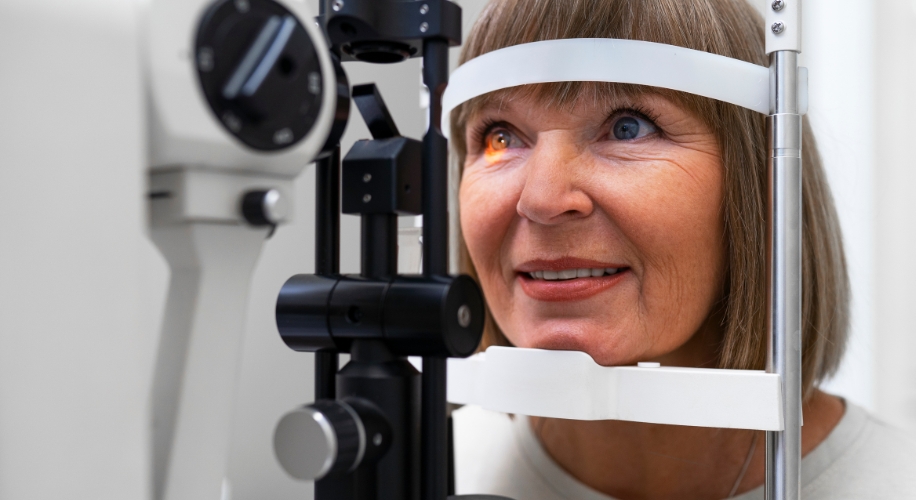Understanding Cataracts: Causes, Symptoms, and Types

June is Cataract Awareness Month, making it the perfect time to shed light on this common eye condition. Cataracts are especially prevalent among older adults and can significantly affect vision. In this blog, we’ll delve into what cataracts are, their causes, symptoms, and the different types. Understanding these aspects is crucial for maintaining eye health and seeking timely treatment.
What Are Cataracts?
Cataracts are a clouding of the eye’s natural lens, which lies behind the iris and the pupil. This clouding can interfere with vision, making it difficult to see clearly. The lens is made primarily of water and protein, and cataracts occur when the protein clumps together, forming a cloudy area. Over time, cataracts can grow larger and cloud more of the lens, making it harder to see.
Causes of Cataracts
Several factors can contribute to the development of cataracts, including:
- Aging: The most common cause, as the lens proteins degrade over time.
- Genetics: A family history of cataracts can increase your risk.
- UV Radiation: Excessive exposure to ultraviolet light from the sun can hasten cataract formation.
- Medical Conditions: Diabetes, obesity, and high blood pressure are linked to an increased risk.
- Smoking: These habits can contribute to the development of cataracts.
- Eye Injuries: Previous eye surgery or trauma can increase the likelihood of cataracts.
- Medications: Long-term use of corticosteroids can lead to cataracts.
Photo by Josh Hild
Symptoms of Cataracts
Cataracts develop slowly and initially may not affect your vision. However, over time, you might notice symptoms such as:
- Blurry Vision: Like looking through a frosty or fogged-up window.
- Difficulty with Night Vision: Seeing at night becomes more challenging.
- Sensitivity to Light: Glare from headlights or the sun can be bothersome.
- Halos Around Lights: Seeing halos around lights, especially at night.
- Frequent Prescription Changes: Needing stronger glasses or contact lenses more often.
- Fading or Yellowing of Colors: Colors appear less vivid or more yellow.
Types of Cataracts
There are several types of cataracts, each affecting the lens differently:
Nuclear Cataracts:
- Location: Center of the lens.
- Characteristics: Initially, they may improve near vision temporarily (second sight), but as they progress, they cause the lens to turn yellow and further impair vision.
- Symptoms: Blurry vision, difficulty seeing in dim light, and changes in color perception.
Cortical Cataracts:
- Location: Edges of the lens, progressing inward.
- Characteristics: White, wedge-like opacities or streaks that extend from the outer edge of the lens toward the center.
- Symptoms: Glare, halos around lights, and difficulty with depth perception.
Posterior Subcapsular Cataracts:
- Location: Back of the lens.
- Characteristics: Small, opaque areas that form at the back of the lens, directly in the path of light.
- Symptoms: Difficulty reading, reduced vision in bright light, and seeing halos around lights at night.
Importance of Regular Eye Exams and Healthy Lifestyle Choices
Regular eye exams are crucial for detecting cataracts early and managing them effectively. During an eye exam, your optometrist can spot the early signs of cataracts and recommend appropriate interventions. Here are some lifestyle choices to help maintain eye health:
- Wear Sunglasses: Protect your eyes from harmful UV rays by wearing sunglasses with UV protection.
- Quit Smoking: Reducing or eliminating smoking can lower your risk.
- Eat a Healthy Diet: Foods rich in antioxidants, such as leafy greens, fruits, and vegetables, can promote eye health.
- Manage Health Conditions: Keep conditions like diabetes and high blood pressure under control.
Cataracts are a common yet treatable condition that can significantly impact your vision and quality of life. By understanding the causes, symptoms, and types of cataracts, you can take proactive steps to protect your eye health. Regular eye exams and healthy lifestyle choices are essential in preventing and managing cataracts, ensuring you maintain clear and healthy vision for years to come. At Zenni, we are committed to supporting your eye health journey with stylish and functional eyewear options.







 Canada
Canada